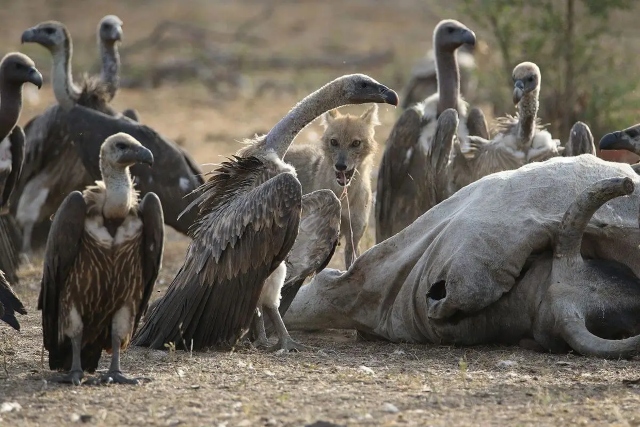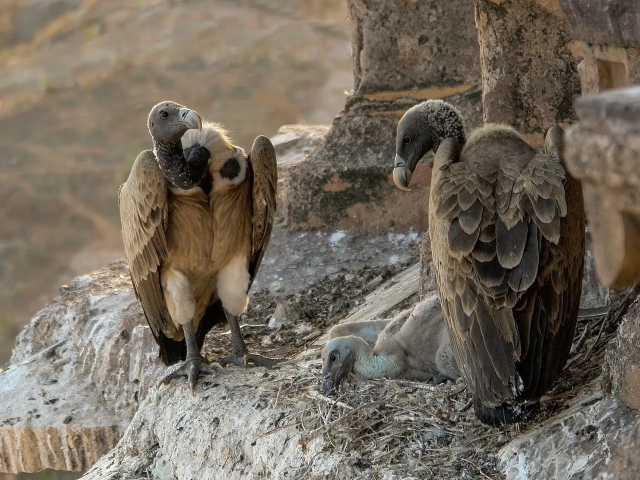The Decline Of Indian Vultures May Have Led To 500,000 Human Deaths – 2oceansvibe News
[imagesource:animaliabio]
Vultures used to be a common sight in India, with the scavenger birds in abundance at the sprawling landfills or hovering above, looking for animal carcasses.
But, two decades ago a new drug was introduced to treat sick cows, and ever since then the vulture population in India has been declining.
Diclofenac, a cheap non-steroidal painkiller for cattle, is believed to have decimated the vulture population from a peak of 50 million, to near zero, with at least three species having suffered long-term losses of 91-98%.
Fortunately, in 2006 the Indian government banned the use of Diclofenac, which helped arrest the decline somewhat, but a peer-reviewed study has now shown that it was not only the vultures who suffered because of the livestock drug, but humans too.
The unintentional decimation of these heavy, scavenging birds allowed deadly bacteria and infections to proliferate, leading to the deaths of about half a million people over five years, according to the study published in the American Economic Association journal.
The study’s co-author, Eyal Frank, an assistant professor at the University of Chicago’s Harris School of Public Policy, says “Understanding the role vultures play in human health underscores the importance of protecting wildlife, and not just the cute and cuddly.”
“They all have a job to do in our ecosystems that impacts our lives.”
“Vultures are considered nature’s sanitation service because of the important role they play in removing dead animals that contain bacteria and pathogens from our environment – without them, disease can spread.”
Mr Frank and his co-author, Anant Sudarshan, compared human death rates in Indian regions where vultures had thrived versus those with historically low vulture numbers – both before and after the vulture decline. They also looked at rabies vaccination sales, feral dog populations, and pathogen levels in the water supply.

Indian Vultures [image:animaliabio]
They discovered that as anti-inflammatory medicine sales grew and vulture populations plummeted, human mortality rates increased by more than 4% in areas where the birds had thrived. The researchers also discovered that the effect was most pronounced in metropolitan areas with big animal populations and frequent corpse disposal.
The authors reckon that between 2000 and 2005, the loss of vultures caused around 100,000 additional human deaths annually, resulting in more than $69bn (R1.2 trillion) per year in mortality damages and economic costs associated with premature deaths.
Most of these deaths could be traced to the spread of diseases and bacteria that vultures would have otherwise removed from the environment.
As an example, the authors noted that as the vultures declined, stray dog populations increased, which led in turn to increased numbers of people getting rabies. Unlike the vultures, dogs don’t dispose of rotting carcasses as efficiently as their winged counterparts and dangerous pathogens are also introduced into water systems by the dogs.
“The vulture collapse in India provides a particularly stark example of the type of hard-to-reverse and unpredictable costs to humans that can come from the loss of a species.”
“In this case, new chemicals were to blame, but other human activities – habitat loss, wildlife trade, and now climate change – have an impact on animals and, in turn, on us. It’s important to understand these costs and target resources and regulations towards preserving especially these keystone species.”
With a livestock population of approximately 500 million animals, vultures are a crucial link in nature’s food chain. Although the decline has been slowed, most of the remaining vulture populations are concentrated around protected areas, which means the populations around areas with the most livestock are still too low to be an effective deterrent to the dangers posed to humans.
The dwindling availability of carcasses, due to increased burial and competition from feral dogs, as well as quarrying and mining activity can disrupt nesting habitats for some vulture species, making their comeback even more difficult.
Vultures may get a bad rep, but without them, humans are in trouble.
[source:bbc]















Post Comment